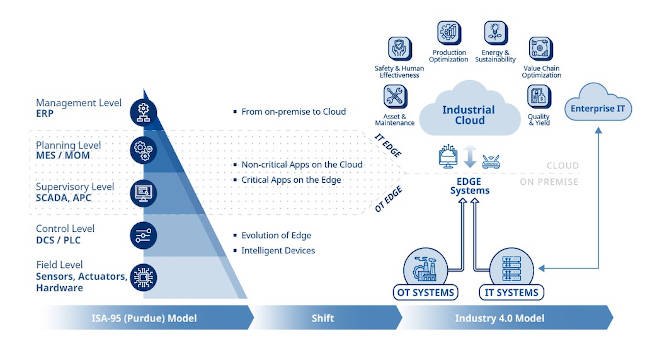Advancing from industrial automation to industrial autonomous operations
A major controls vendor focuses on industry, uses cloud-based software, artificial intelligence and advanced robotics integration to move customers from industrial automation to autonomous operations.
Learning Objectives
- Consider advancing maturity levels from industrial automation to industrial autonomous operations.
- Use cloud-based software to save industrial project resources.
- Fill the skills gap by upscaling automation with artificial intelligence (AI) and integrating advanced robotics platforms.
By refocusing on industries, Yokogawa advances customers from industrial automation to industrial autonomous operations. Using cloud-based software saves industrial project resources. Upscaling automation with artificial intelligence (AI) helps fill the skills gap. Better integration of advanced robotics platforms will help. On Nov. 1, as part of Y NOW 2021: Realizing Autonomous Operations virtual event, a Yokogawa roundtable session for media covered industrial autonomy trends.
Yokogawa reorganizes to focus on industries
Yokogawa, traditional centered on conventional products and functions, changed its organizational focus in April based on industry to add sustainable value, said Kevin McMillen, president and CEO, Yokogawa North America. These are:
- Energy and sustainability (oil and gas, petrochemicals, renewable energy, electric power, energy management services and energy storage)
- Materials (functional chemicals, biomass materials, pulp and paper, textiles, steel, non-ferrous metals, mining, mobility and electrical/electronics)
- Life (pharmaceuticals, healthcare, food and water)
- Measuring instruments (energy info-communications, healthcare).
- New businesses and other (bio-related, aviation, new business)
- Exploration (disaster prevention, space, ocean).
In helping customers sustain growth, there’s an effort to expand from industrial automation to industrial autonomy, a systems-of-systems concept, McMillen said, helping customers with prioritization of solutions and outcomes. Enabling technologies include AI, 3D digital twins and robotics.

Figure 1: As industry shifts from a layered ISA-95 (Purdue) Model, and moves more toward an Industry 4.0 model, Yokogawa OpreX products, services and solutions helps customers add value leading to industrial autonomy. Yokogawa Cloud helps data enablement, data curation, data analytics, cybersecurity and identity management. Courtesy: Yokogawa
Moving from industrial automation to industrial autonomy
Tom Fiske, Ph.D., principal technology strategist, discussed trends in making autonomous operations that have the agility to pivot in a post-COVID world.
Digital transformation has impacted every aspect of society, Fiske said, including facility operations. See Figure 1. Integrating production, logistics and supply chain is the next step in smart manufacturing. The transition from industrial automation to industrial autonomy (IA2IA) is next concept. Operations increase in maturity level from manual (reactive maintenance), semi-automated (reactive and scheduled maintenance), automated (condition-based maintenance), semi-autonomous (predictive maintenance), autonomous orchestration (prescriptive maintenance), to autonomous operations (self-healing assets with 3D printing and robotic installation). People will perform tasks in between using special-purpose applications.
Digital transformation, as systems combine into systems of systems, moves from devices to units to areas. Capabilities and functionalities increase as systems combine, Fiske said.
Cloud-based software saves industrial project resources
Joseph Ting, vice president of digital customer experience, based in Singapore, talked about benefits of the Yokogawa Cloud in accelerating and transforming the Yokogawa software portfolio. Ting said in an application of Yokogawa Enterprise KPI Dashboard for Production Monitoring based on process and sensor data resulted in a 3x less time in development and 3x less time in application maintenance efforts, 4x increase in products to market, and 20x less code (with codeless configurations). See Figure 2.
The Yokogawa Cloud enables secure connections integration analysis and visualization of data from information technology (IT) and operational technology (OT) systems for better insights and orchestration.

Figure 2: Table shows improvements in industrial project time (from 12 months to 3 months), development effort, total lines of code and average budget (from as much as $1 million to less than $30,000) when using Yokogawa Enterprise KPI Dashboard for Production Monitoring and Yokogwa Cloud. Yokogawa can serve as the main automation contractor. Courtesy: Yokogawa
Filling the skills gap by upscaling automation
Hiroaki Kanokogi, Ph.D., general manager, Yokogawa products HQ control center, suggested there’s a need to pursue autonomous plant systems because retiring workers are worsening the skills gap. In the oil and gas industry, citing the Global Energy Talent Index (GETI), Kanokogi said only 4% of workers are aged 18-24, and 20% are over 55 years of age.
Three types of AI will guide plants to autonomous operations, Kanokogi said: AI that analyzes the present state, AI to explore control methods, and AI to find and define potential problems. The third is just emerging. All three will help fill the skills gap.
More robotics for autonomous plant operations
Layered in along the way to autonomous operations, robotics provide an increased amount of functionality for inspection and measurement, system integration and fleet management, and physical operations with arm manipulation capabilities, said Penny Chen, Ph.D, senior principal technology strategist, Yokogawa.
Robotic application examples include visual inspection, thermal inspection, auditory inspection, gas detection, object detection and 3D mapping. Yokogawa software aggregates information and platforms to manage many systems, she explained. See Figure 3. The software helps resolve three basic needs: 1) Robot management, 2) data orchestration and 3) integrating with existing control and asset management systems. Security and safety also are very important, she said.

Figure 3: Robotics enable industrial autonomy with drones, and robots that match living things in locomotive capabilities, such as beetles, crabs, dogs, geckos, honeybees, snakes and spiders for inspection, manipulation, transport and security, among other uses. Yokogawa software manages multiple robotic platforms. Courtesy: Yokogawa
Mark T. Hoske is content manager, Control Engineering, CFE Media and Technology, mhoske@cfemedia.com.
KEYWORDS: Industry 4.0, industrial autonomous operations, AI, robotics integration
CONSIDER THIS
Are you looking ahead toward industrial autonomous operations or getting left behind in manual?
Do you have experience and expertise with the topics mentioned in this content? You should consider contributing to our CFE Media editorial team and getting the recognition you and your company deserve. Click here to start this process.



